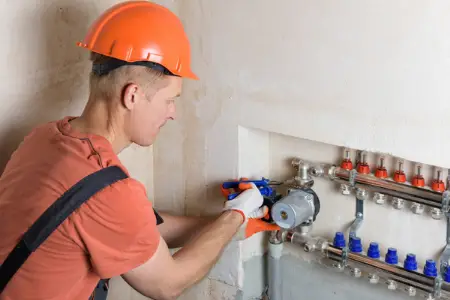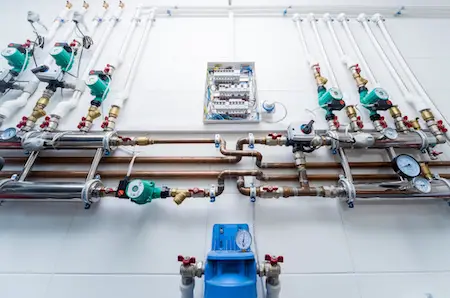A ground source heat pump (also known as a GSHP/Geothermal apparatus) is a heating or cooling system that transfers the earth’s natural energy to provide heating and cooling. It does this by pumping liquid refrigerant through pipes buried in your yard or on another level of your home, then transferring it to an indoor coil for use.

Ground source heat pumps rely on a type of geothermal heating and cooling system that extracts heat from the ground to produce warm air for your home. Ground source heat pumps can also work in reverse, extracting cool air from the ground during the summer months when you need it.
Geothermal heat pump apparatus has a lot of advantages – one of which is that it consumes less energy.
Ground source heat pumps do not consume energy like the usual heating and cooling systems. During the process of obtaining heat from the earth (ground), electrical power is employed. This insinuates that before heating occurs, electrical power is converted into about 5 kilowatts of heating or about 3 kilowatts in the case of cooling.
Geothermal heat pumps adopt the system of refrigeration, in that liquid passing through the tubes that run inside and outside the refrigerator, is compressed using an electric motor and then pumped for it to be able to change its state of matter from liquid to gas and from gas to liquid.
This procedure keeps the tubes outside the refrigerator hot and inside the refrigerator cold, thereby making the inside of the fridge cool and the outside hot. The ground heat pump uses the same methodology.
In the summer, the tubes running inside the building cools it, by getting cool air from the ground. During cold seasons, the ground heat pump works in reverse. The building is kept warm by getting heat from the ground.
Types of Ground Source Heat Pumps
Ground source heat pumps are mainly classified into four depending on their ground loop arrangement.
- Horizontal loop system
- Vertical loop system
- Pond loop system
- Open-loop system
The first three types of ground heat pumps are closed-loop systems. The closed-loop ground heat pumps are more commonly found in residential installations than the open-loop system.

1. Horizontal closed-loop system: This is usually the best for installations for a residential home. It entails placing a ground loop horizontally underground. The ground loop is generally placed between four to six feet under the ground.
2. Vertical closed-loop system: For big edifices and areas whereby, the ground is too shallow or difficult to excavate, this is usually the best type of ground-loop system. In this system, the ground loop is run straight down between 100 and 400 feet after which it then returns to the surface of the soil.
3. Pond closed-loop system: This is the cheapest option, but there is a flaw as it can only be possible where there is a water body nearby. It involves placing a ground loop about eight feet below the surface of a nearby water source.
4. Open-loop ground heat pump system: This method is usually not common. The system circulates well via the warmth pump rather than employing a closed system with an antifreeze liquid inside.
Principle of operation of a ground source heat pump system
A ground source heat pump is an efficient means of heating and cooling your home for a reasonable cost. It’s designed to extract underground temperature fluctuations, and use them as the main energy source.
The ground-source heat pump system consists of three components:
- A refrigerant liquid in an outdoor unit that extracts the earth’s warmth from below your feet
- An indoor air handler that distributes this warmth evenly through your home
- Heat distribution piping buried in trenches or otherwise placed near the earth’s surface
Heat pumps work by transferring energy or thermal energy from one location to another, in this case between the ground and your home.
- Step 1
An antifreeze and water mixture is distributed via a conduit submerged under the ground
The pipe submerged can also be called the ground loop. The method of installation is either flat or steeply under the ground, depending on the space available and how easy it is to install.
- Step 2
Heat absorbed directly under the ground is transferred into the tubing arrangement
During the process of circulation of the blend of antifreeze via the ground by the ground loop, the liquid seizes the heat present in the earth. It happens as a result of the ever-changing temperature of the ground being warmer than that of the liquid, and the heat flows naturally from warmer regions to colder regions.
- Step 3
The collected heat is concentrated by the system’s heat exchanger
As soon as the fluid receives heat from the earth, to provide a convenient temperature in your home, the resulting heat needs to be concentrated.
In a regular ground source heat pump system, the fluid which has undergone cycling via a ground loop moves via a heat exchanger, this is where the seized heat is conveyed to a fluid cycling refrigerant via a different system that is looped. The liquid is then pumped via a compressor which makes the absorbed heat concentrated to a larger degree of temperature in vapourised form.
- Step 4
Finally, the heat is transported into your house
Hot vapour already concentrated moves via another thermal exchanger, that disburses the heat supplied to your home when a breeze is blown across this other heat or thermal exchanger, heat is absorbed and moves throughout your home. As your house starts to get warmed up, the vapour compressed cools.
It is pumped back via the first heat (thermal) exchanger to retrieve more heat energy from the outside earth (ground). This continues to happen to maintain the air temperature inside the house.
During warmer seasons, there is a need for cooling, and the process works in the reverse direction to maintain a cool temperature in the home. Instead of conveying heat from the earth to the home, a heat exchanger pumps the refrigerant inside your home first, it takes in heat energy and transports it down via the ground loop to disburse heat into the ground.
